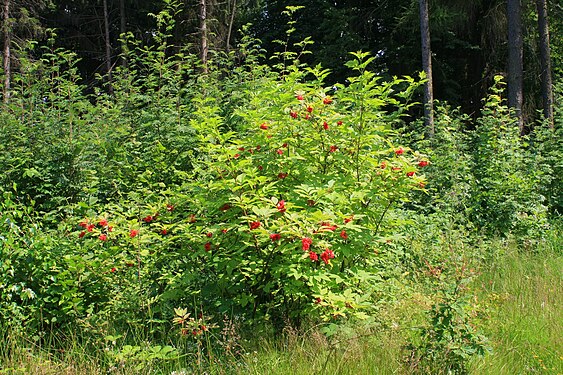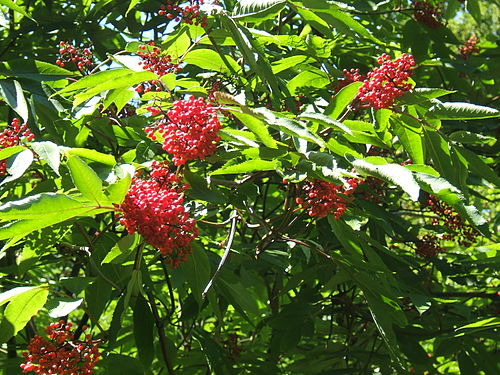Difference between revisions of "Sambucus racemosa"
(New page: __NOTOC__{{Plantbox | name = ''LATINNAME'' <!--- replace LATINNAME with the actual latin name --> | common_names = <!--- if multiple, list all, if none, leave blank --> | growth_habi...) |
|||
| (One intermediate revision by one other user not shown) | |||
| Line 1: | Line 1: | ||
| − | + | {{SPlantbox | |
| − | | | + | |familia=Caprifoliaceae |
| − | | | + | |genus=Sambucus |
| − | | | + | |species=racemosa |
| − | | | + | |common_name=European red elder, Red elderberry |
| − | | | + | |name_ref=Flora - A Gardener's Encyclopedia |
| − | | | + | |habit=shrub |
| − | | | + | |habit_ref=Flora - A Gardener's Encyclopedia |
| − | | | + | |Max ht box=12 |
| − | | | + | |Max ht metric=ft |
| − | | | + | |height_ref=Flora - A Gardener's Encyclopedia |
| − | | | + | |Max wd box=12 |
| − | | | + | |Max wd metric=ft |
| − | | | + | |width_ref=Flora - A Gardener's Encyclopedia |
| − | | | + | |lifespan=perennial |
| − | | | + | |life_ref=Flora - A Gardener's Encyclopedia |
| − | | | + | |exposure=sun |
| − | | | + | |sun_ref=Flora - A Gardener's Encyclopedia |
| − | | | + | |features=deciduous, flowers |
| − | | | + | |flower_season=early spring, mid spring, late spring, early summer, mid summer, late summer |
| − | | | + | |flower_ref=Flora - A Gardener's Encyclopedia |
| − | | | + | |flowers=white |
| − | | | + | |Temp Metric=°F |
| − | | | + | |min_zone=4 |
| − | | | + | |usda_ref=Flora - A Gardener's Encyclopedia |
| − | | | + | |max_zone=9 |
| − | | | + | |image=Sambucus racemosa a1.jpg |
| − | | | + | |image_width=240 |
| − | |||
}} | }} | ||
| + | '''''Sambucus racemosa''''' is a species of [[Sambucus|elderberry]] known by the common name '''red elderberry'''. It is native to Europe, temperate Asia, and the northern half of North America.<ref name=grin>[http://www.ars-grin.gov/cgi-bin/npgs/html/taxon.pl?33001 GRIN Species Profile]</ref> It grows in [[Riparian zone|riparian]] environments, woodlands, and other habitat, generally in moist areas.<ref name=npin>[http://www.wildflower.org/plants/result.php?id_plant=sara2 NPIN Database]</ref> This often treelike [[shrub]] grows 2 to 6 meters tall. The stems are soft with a [[pith]]y center. Each individual leaf is composed of 5 to 7 leaflike leaflets, each of which is up to 16 centimeters long, lance-shaped to narrowly oval, and irregularly serrated along the edges. The leaflets have a strong disagreeable odor when crushed.<ref name= duke>[http://www.duke.edu/~cwcook/trees/sara.html Duke Photo Profile: var. ''pubens'']</ref> The [[inflorescence]] is a vaguely cone-shaped [[panicle]] of several cymes of flowers blooming from the ends of stem branches. The flower buds are pink when closed, and the open flowers are white, cream, or yellowish. Each flower has small, recurved petals and a star-shaped axis of five white [[stamen]]s tipped in yellow anthers. The flowers are fragrant and visited by [[hummingbird]]s and [[Butterfly|butterflies]].<ref name=npin/> The fruit is a bright red or sometimes purple [[drupe]] containing 3 to 5 seeds. The fruits are popular with birds, who distribute the seeds.<ref name=pojar>Pojar, J. & A. MacKinnon. (1994). ''Plants of the Pacific Northwest''. Lone Pine Publishing. ISBN 1-55105-042-0</ref> | ||
| + | |||
| + | Many parts of this plant are [[toxin|poisonous]], and have been used as a traditional [[vomiting|emetic]].<ref name=npin/> The fruits are reportedly safe to eat when cooked, and were savored by the [[Gitxsan]] in a variety of recipes.<ref name=npin/> | ||
| + | |||
{{Inc| | {{Inc| | ||
| − | + | Sambucus racemosa, Linn. Red-berried Elder. Shrub, to 12 ft.: branches light brown; young branchlets glabrous or nearly so, 2-3 1/2 in. long: infl. ovate or oblong, dense: lfts. 5-7, ovate or elliptic to ovate-lanceolate, glabrous, 2-3 in. long: fls. yellowish white: fr. scarlet, 1/4 in. across, 3-seeded; nutlets yellowish white, minutely rugose. April, May; fr. in June, July. Eu. to E. Asia. Var. nana, Carr. Dwarf compact form. Var. plumosa, Carr. Lfts. incisely serrate to about the middle, teeth long and narrow, purplish when unfolding. Var. plumoso-aurea Weezelenburg (var. serratifolia aurea, Barbier). Foliage like that of the preceding form, but golden yellow. Var. ornata, Carr. (var. pteridifolia, Carr.). The first lvs. of the shoot are like those of var. plumosa, the later ones more finely dissected like var. laciniata. Var. laciniata, W. Koch (var. serratifolia, Hort.). Lfts. regularly and deeply dissected, green when unfolding.Var. tenuifolia, Carr. Lvs. finely and deeply dissected with very narrow segms., purplish when unfolding. Var. purpurea, Sweet (S. rosiflora, Carr.). Fls. purplish or pink outside, purple in bud. Var. flavescens, Sweet (var. xanthocarpa, Zabel). Fr. yellow with orange cheek. — This species, like the following, is not conspicuous in bloom, but the clusters of scarlet fr. are very attractive in June and July. The cut-leaved forms are very graceful. | |
| − | Sambucus racemosa, Linn. Red-berried Elder. Shrub, to 12 ft.: branches light brown; young branchlets glabrous or nearly so, 2-3 1/2 in. long: infl. ovate or oblong, dense: lfts. 5-7, ovate or elliptic to ovate-lanceolate, glabrous, 2-3 in. long: fls. yellowish white: fr. scarlet, 1/4 in. across, 3-seeded; nutlets yellowish white, minutely rugose. April, May; fr. in June, July. Eu. to E. Asia | ||
{{SCH}} | {{SCH}} | ||
}} | }} | ||
==Cultivation== | ==Cultivation== | ||
| − | + | ||
===Propagation=== | ===Propagation=== | ||
| − | + | ||
===Pests and diseases=== | ===Pests and diseases=== | ||
| − | |||
| − | == | + | |
| − | + | ==Varieties== | |
| + | |||
==Gallery== | ==Gallery== | ||
| − | |||
| − | <gallery> | + | <gallery perrow=5> |
| − | + | File:Sambucus racemosa 20090629.jpg | |
| − | + | File:Sambucus racemosa2.jpg | |
| − | + | File:Sambucus racemosa.jpg | |
</gallery> | </gallery> | ||
==References== | ==References== | ||
| + | <references/> | ||
*[[Standard Cyclopedia of Horticulture]], by L. H. Bailey, MacMillan Co., 1963 | *[[Standard Cyclopedia of Horticulture]], by L. H. Bailey, MacMillan Co., 1963 | ||
<!--- xxxxx *Flora: The Gardener's Bible, by Sean Hogan. Global Book Publishing, 2003. ISBN 0881925381 --> | <!--- xxxxx *Flora: The Gardener's Bible, by Sean Hogan. Global Book Publishing, 2003. ISBN 0881925381 --> | ||
| Line 66: | Line 68: | ||
{{stub}} | {{stub}} | ||
| − | + | __NOTOC__ | |
| − | |||
| − | |||
Latest revision as of 23:46, 10 May 2010
| Habit | shrub
| |
|---|---|---|
| Height: | ⇕ | 12 ft"ft" can not be assigned to a declared number type with value 12. |
| Width: | ⇔ | 12 ft"ft" can not be assigned to a declared number type with value 12. |
| Lifespan: | ⌛ | perennial |
| Bloom: | ❀ | early spring, mid spring, late spring, early summer, mid summer, late summer |
| Exposure: | ☼ | sun |
|---|---|---|
| Features: | ✓ | deciduous, flowers |
| USDA Zones: | 4 to 9 | |
| Flower features: | ❀ | white |
|
Sambucus > |
racemosa > |
Sambucus racemosa is a species of elderberry known by the common name red elderberry. It is native to Europe, temperate Asia, and the northern half of North America.[1] It grows in riparian environments, woodlands, and other habitat, generally in moist areas.[2] This often treelike shrub grows 2 to 6 meters tall. The stems are soft with a pithy center. Each individual leaf is composed of 5 to 7 leaflike leaflets, each of which is up to 16 centimeters long, lance-shaped to narrowly oval, and irregularly serrated along the edges. The leaflets have a strong disagreeable odor when crushed.[3] The inflorescence is a vaguely cone-shaped panicle of several cymes of flowers blooming from the ends of stem branches. The flower buds are pink when closed, and the open flowers are white, cream, or yellowish. Each flower has small, recurved petals and a star-shaped axis of five white stamens tipped in yellow anthers. The flowers are fragrant and visited by hummingbirds and butterflies.[2] The fruit is a bright red or sometimes purple drupe containing 3 to 5 seeds. The fruits are popular with birds, who distribute the seeds.[4]
Many parts of this plant are poisonous, and have been used as a traditional emetic.[2] The fruits are reportedly safe to eat when cooked, and were savored by the Gitxsan in a variety of recipes.[2]
Read about Sambucus racemosa in the Standard Cyclopedia of Horticulture
|
|---|
|
Sambucus racemosa, Linn. Red-berried Elder. Shrub, to 12 ft.: branches light brown; young branchlets glabrous or nearly so, 2-3 1/2 in. long: infl. ovate or oblong, dense: lfts. 5-7, ovate or elliptic to ovate-lanceolate, glabrous, 2-3 in. long: fls. yellowish white: fr. scarlet, 1/4 in. across, 3-seeded; nutlets yellowish white, minutely rugose. April, May; fr. in June, July. Eu. to E. Asia. Var. nana, Carr. Dwarf compact form. Var. plumosa, Carr. Lfts. incisely serrate to about the middle, teeth long and narrow, purplish when unfolding. Var. plumoso-aurea Weezelenburg (var. serratifolia aurea, Barbier). Foliage like that of the preceding form, but golden yellow. Var. ornata, Carr. (var. pteridifolia, Carr.). The first lvs. of the shoot are like those of var. plumosa, the later ones more finely dissected like var. laciniata. Var. laciniata, W. Koch (var. serratifolia, Hort.). Lfts. regularly and deeply dissected, green when unfolding.Var. tenuifolia, Carr. Lvs. finely and deeply dissected with very narrow segms., purplish when unfolding. Var. purpurea, Sweet (S. rosiflora, Carr.). Fls. purplish or pink outside, purple in bud. Var. flavescens, Sweet (var. xanthocarpa, Zabel). Fr. yellow with orange cheek. — This species, like the following, is not conspicuous in bloom, but the clusters of scarlet fr. are very attractive in June and July. The cut-leaved forms are very graceful. CH
|
Cultivation
Propagation
Pests and diseases
Varieties
Gallery
References
- ↑ GRIN Species Profile
- ↑ 2.0 2.1 2.2 2.3 NPIN Database
- ↑ Duke Photo Profile: var. pubens
- ↑ Pojar, J. & A. MacKinnon. (1994). Plants of the Pacific Northwest. Lone Pine Publishing. ISBN 1-55105-042-0
- Standard Cyclopedia of Horticulture, by L. H. Bailey, MacMillan Co., 1963
External links
- w:Sambucus racemosa. Some of the material on this page may be from Wikipedia, under the Creative Commons license.
- Sambucus racemosa QR Code (Size 50, 100, 200, 500)



